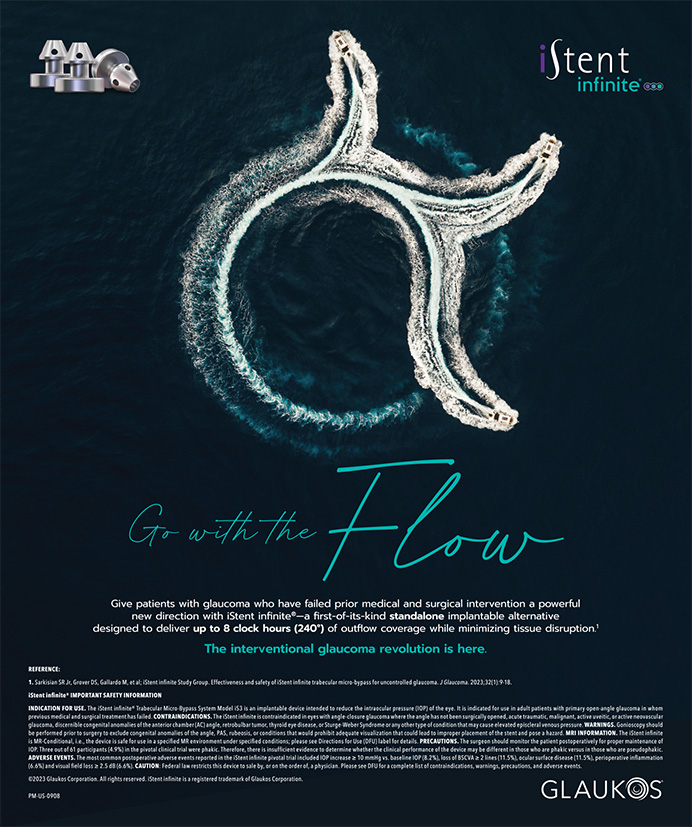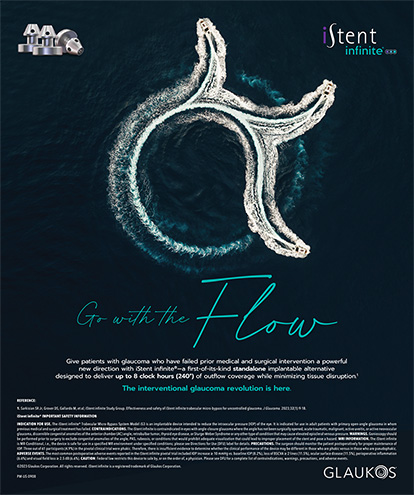What tricks do you use to improve your success with capsular tension rings (CTRs) with regard to timing,
instrumentation, and technique?
—Topic prepared by Steven Dewey, MD.
Marjan Farid, MD
CTRs are excellent adjuncts for cases in which zonular weakness is seen or suspected. I place a CTR in eyes with posttraumatic cataracts and in all eyes with pseudoexfoliation (PXF) syndrome. When this device is in place, even on a currently centered capsular bag, late anterior phimosis and zonular dehiscence will not cause the IOL's haptics to fold inward. Even if there is significant zonular dehiscence and late dislocation of the IOL-capsular bag complex, a CTR will permit straightforward suturing of this complex to the scleral wall with an ab interno lasso technique. I prefer to place the CTR as late as possible during the case to avoid trapping cortical material or at least to minimize the problem. The scalloped tension rings reduce the amount of cortical material that is trapped and allow for easy I/A. The specialized loader and injector for the CTR work well for manipulating the device and deliver it slowly and deliberately into the capsular bag. The leading point of the CTR should be directed toward the area of zonular weakness as it is delivered. This technique ensures that that the “butt” of the device is maximally up against the weakest zone and pushing the bag out in that direction.
Roger Furlong, MD
This broad question covers different types of CTRs, but some general principles can be followed when using these devices. I use standard CTRs (no suture fixation) in eyes with less than 3 or 4 clock hours of zonular weakness and when the zonulopathy is not progressive such as in eyes with trauma. The general maxim of placing a CTR “as late as possible but as soon as necessary” is good advice, because CTRs make cortical removal more difficult. The devices should be placed as early as needed, however, to stabilize the capsule safely. I prefer using an injector, and some CTRs come with a disposable injector. CTRs can be safely placed with a twohanded technique, but regardless of technique, the trailing end of the CTR must end up in the capsular bag; recovering it from the sulcus can be very difficult.
For cases involving significant zonular loss or expected progression of the zonulopathy, as with PXF, a suturefixated CTR may be needed. When in doubt, I place a CTR with two suture-fixation eyelets, even if I conclude at the end of the case that only one of the eyelets is required. A CTR with two suture-fixation eyelets gives me options, depending on how the case progresses. Capsular segments with fixation eyelets can be used intraoperatively to stabilize the bag, and they can remain in the eye, suture fixated to the sclera as needed. Among the most useful instruments for all these cases are micrograsping forceps, which ease intraocular manipulation and the placement of these devices.
Gerald J. Roper, MD
When surgical challenges necessitate a CTR, the most valuable advice is also the most basic: constantly reassess the situation and respond to the findings immediately as they occur. If early intraoperative findings arouse suspicion, have your “Loose Lens Protocol” (which is preprepared and in your OR) and your back-up instrument kit and CTR supplies ready. Aside from monitoring the obviously pressing issues (management of the anterior chamber, lower flow, viscoelastic patching, staying calm with yoga breathing, etc.), I decide early during the creation of the capsulorhexis whether capsular support is necessary to prevent further zonular loss, and if pragmatic, I use capsular support system hooks such as the MicroSurgical Technology Capsule Retractors or the Mackool Cataract Support System (FCI Ophthalmics, Inc., and Crestpoint Management Ltd.). Standard iris hooks work well, too.
I prefer to remove the lion's share of the cataract before placing a CTR, but I constantly reassess the situation and place the device as necessary to keep the lens capsule and zonules safe. When the time to place the CTR has arrived, I prefer the Henderson CTR (Morcher GmbH; distributed in the United States by FCI Ophthalmics, Inc.), a serrated gem with a plethora of advantages. Its oscillatory shape is easy to see. The device is delivered well by an injection inserter, and this CTR is easy to manually feed with a forceps, which holds the ring flat if the surgeon spans the forceps across a couple of serrations coplanar with the lens. Additionally, residual lenticular cortex is considerably easier to remove with the Henderson CTR in place compared with other CTRs, which was the intention of the device's design.
Slow injection of the CTR will almost always result in its safe placement into the lens capsule. If the capsule seems unstable for standard-feed placement of the CTR, then I consider bimanual crossing of the CTR's eyelets. I use a Sinskey hook in the forward eyelet to bow the ring as it feeds out of the injector. Then, I advance the distal loop into the capsule, and release the proximal eyelet ends within the capsulorhexis at the same time for evenly distributed tension.
Section Editor Alan N. Carlson, MD, is a professor of ophthalmology and chief, corneal and refractive surgery, at Duke Eye Center in Durham, North Carolina.
Section Editor Steven Dewey, MD, is in private practice with Colorado Springs Health Partners in Colorado Springs, Colorado. Dr. Dewey may be reached at (719) 473-4507; sdewey@cshp.net.
Section Editor R. Bruce Wallace III, MD, is the medical director of Wallace Eye Surgery in Alexandria, Louisiana. Dr. Wallace is also a clinical professor of ophthalmology at the Louisiana State University School of Medicine and an assistant clinical professor of ophthalmology at the Tulane School of Medicine, both located in New Orleans.
Marjan Farid, MD, is the director of cornea, refractive, and cataract surgery; vice-chair of ophthalmic faculty; codirector of the Cornea Fellowship Program; and an associate professor of ophthalmology at the Gavin Herbert Eye Institute at the University of California, Irvine. Dr. Farid may be reached at (949) 824-2020; mfarid@uci.edu.
Roger Furlong, MD, is a practitioner at Rocky Mountain Eye Center in Missoula, Montana. Dr. Furlong may be reached at rcfurlong1@aol.com.
Gerald J. Roper, MD, is in private practice in Batesville, Indiana. He acknowledged no financial interest in the products or companies he mentioned. Dr. Roper may be reached at (812) 934-9400; ropercare@mac.com.


